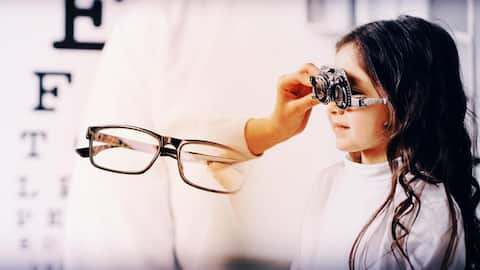One in three children now affected by myopia, says study
What's the story
A recent global analysis indicates a steady decline in children's eyesight, with one in three children now suffering from short-sightedness or myopia. The study suggests that the COVID-19 lockdowns have adversely affected children's vision due to increased screen time and reduced outdoor activities. The research warns of myopia becoming a significant global health concern, potentially affecting millions more children by 2050.
Asian predicament
Asia records highest rates of child myopia
Asia reports the highest rates of myopia among children, with Japan leading at 85% and South Korea following closely at 73%. Over 40% of children in China and Russia are also affected by short-sightedness. In contrast, Paraguay and Uganda report some of the lowest levels of myopia at about 1%. The UK, Ireland, and the US show a moderate prevalence rate hovering around 15%.
Myopia research
Comprehensive study reveals myopia tripled since 1990
The study, published in the British Journal of Ophthalmology, analyzed data from over five million children and teenagers across 50 countries on all six continents. The researchers found that the prevalence of short-sightedness tripled between 1990 and 2023, rising to 36%. They noted a "particularly notable" increase following the COVID-19 pandemic. The research also highlighted that myopia typically begins during primary school years and tends to worsen until around age 20 when eye growth ceases.
Educational impact
Early education and myopia: A possible connection
The study highlights that factors like geography, genetics, and early education influence the development of myopia. Children in East Asia, starting school as early as two, face a higher risk due to prolonged screen and book exposure, straining their eye muscles. This contributes to a higher prevalence of myopia. In contrast, Africa, where school typically starts at six to eight years old, has a seven times lower incidence of myopia, emphasizing the impact of delayed formal education on eye health.
Pandemic impact
COVID-19 lockdowns accelerate vision deterioration in youth
The global COVID-19 lockdowns, which confined millions indoors for long periods, have negatively impacted children's and teenagers' vision. Researchers have found emerging evidence linking the pandemic to accelerated vision deterioration in young adults. By 2050, it is predicted that over half of teens worldwide could be affected by myopia. The study also highlights that girls and young women may have higher rates of myopia than boys, attributed to spending less time outdoors during their school years and at home.
Future projections
Myopia rates expected to rise globally by 2050
The study predicts that Asia will continue to have the highest levels of myopia compared to all other continents by 2050, with nearly 69% of children expected to be short-sighted. However, developing countries are also projected to see a significant increase in myopia rates, potentially reaching up to 40%. The researchers attribute these trends partly to girls' earlier growth and development stages, which may lead them to experience short-sightedness at an earlier age.
Eye care
Protecting children's eyesight: Expert recommendations
UK eye experts suggest children spend at least two hours outdoors daily, especially between ages seven and nine, to reduce the risk of myopia. The exact reasons for this recommendation are not fully understood, but it may relate to natural sunlight exposure, outdoor exercise, or focusing on distant objects. Daniel Hardiman-McCartney from the UK College of Optometrists emphasizes outdoor activities' benefits and advises parents to have their children's eyes tested between ages seven and 10.
